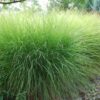Miscanthus sinensis Gracillimus
Price range: £7.50 through £9.50
Frequently Bought Together



Description
Quick Facts
- Common Name: Maiden Grass, Graceful Miscanthus
- Botanical Name: Miscanthus sinensis ‘Gracillimus’
- Plant Type: Deciduous ornamental grass
- Mature Height: 120-150cm
- Mature Spread: 90-120cm
- Flowering Period: September-October
- Flower Colour: Silvery-pink plumes fading to buff
- Foliage: Narrow green with prominent white midrib
- Hardiness: RHS H6 (hardy, -15 to -20°C)
- Soil Requirements: Moist, well-drained, tolerates most soil types
- Aspect: Full sun to partial shade
- Maintenance: Low
Description
Like a graceful fountain frozen in time, Miscanthus sinensis ‘Gracillimus’ brings elegant architecture and seasonal drama to English gardens with its refined habit and spectacular autumn transformation. This classic ornamental grass creates a living sculpture that changes with the seasons, offering structure and movement that perfectly captures the essence of naturalistic garden design.
The slender, arching leaves emerge fresh green in spring, each blade adorned with a distinctive white central stripe that catches the light beautifully throughout the growing season. As the plant matures, it forms an elegant upright clump with a gracefully weeping habit, creating a fountain-like silhouette that adds vertical interest to borders and landscapes.
In early autumn, the magic truly unfolds as silvery-pink flower plumes emerge like delicate brushstrokes against the sky, gradually fading to warm buff tones that persist through winter. The entire plant transforms into a golden tapestry as temperatures drop, providing months of warm colour when most other plants have retreated into dormancy.
Perfect for creating contemporary garden designs or adding structure to traditional borders, ‘Gracillimus’ excels as a specimen plant or in mass plantings. Its tolerance of Irish weather conditions and ability to thrive in various soil types makes it invaluable for modern landscapes, whilst its winter silhouette provides architectural beauty through the coldest months.
Caragh Garden Notebook
Plant in moist, well-drained soil enriched with organic matter. Tolerates clay, loam, and sandy soils but performs best with consistent moisture during growing season. Space plants 90-120cm apart to allow for full development.
Thrives in full sun for best flowering and autumn colour but tolerates partial shade. Water regularly during first growing season and in dry spells. Benefits from annual mulch of compost or well-rotted manure in spring.
Cut back to 15-20cm in late winter or early spring before new growth begins. Leave standing through winter for structural interest and wildlife habitat. Divide established clumps every 4-5 years in spring to maintain vigour.
Propagate by division in spring when new growth appears. Lift clumps carefully and divide using sharp spade or knife, ensuring each section has roots and growing points. Can be grown from seed but named varieties may not come true to type.
Excellent for adding height and movement to mixed borders. Provides valuable winter habitat for beneficial insects and small birds. The dried seed heads are attractive to goldfinches and other seed-eating birds.





